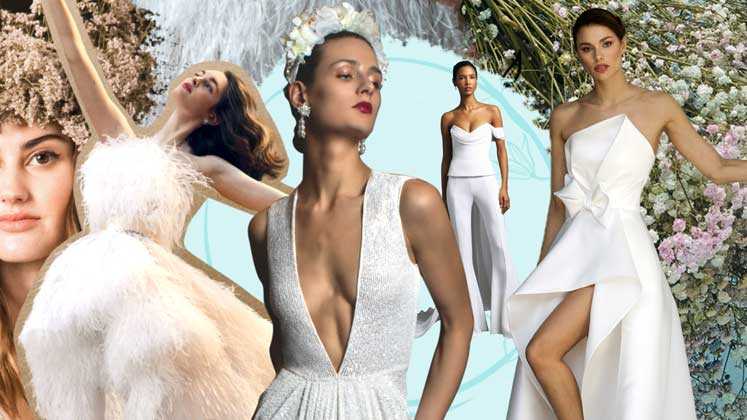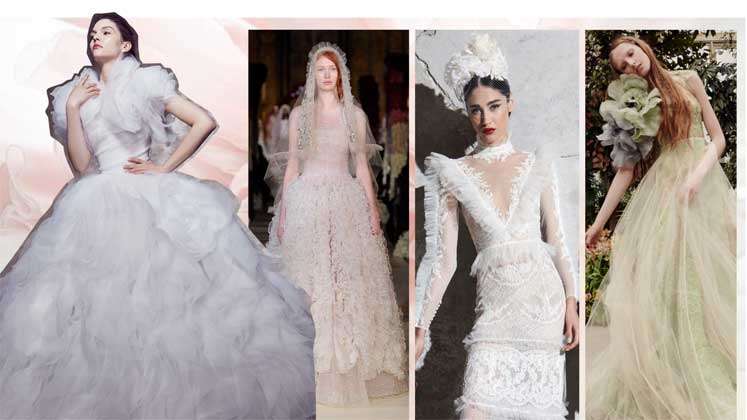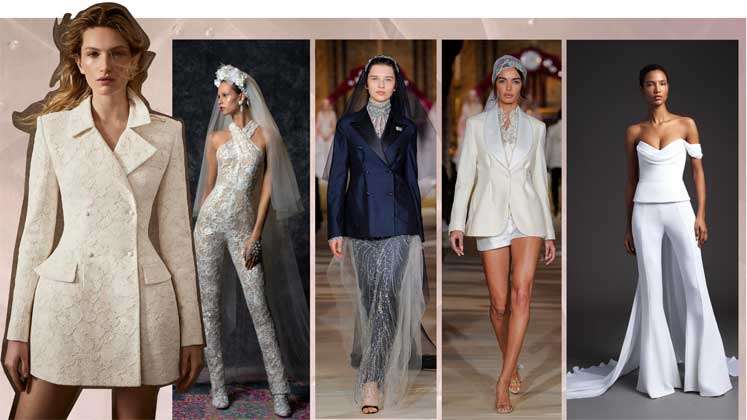
Bridalwear is one of the most decorated, flourishing and constantly growing segments, as the consumer is ready to go all out on wedding attires as the garment’s intrinsic value to the wearer supersedes that of other segments. The trend of having a small, yet ostentatious wedding is marking a major change in the consumer behaviour, as buyers are now more open to spending on the smaller details such as the ‘perfect wedding dress’ rather than going for a big wedding. The success of the bridalwear market is supported by the recent study done by statista.com , which values the global market value of wedding dresses at US $ 32.5 billion(2017), and has forecasted it to reach about US $ 43.5 billion by 2022.
The bridalwear market is evolving with the changing consumer psyche as the conventional wedding dresses that were once right out of a fairy-tale are now giving ways to wedding outfits that champion functionality and the ease of the bride; styles such as pantsuits and blazer dresses which were a fresh new addition to the mix for Spring 2020. Major couture and design houses are catching up with the minimal bride trend rapidly, whether in the form of silhouettes, fabrics or the overall ensemble itself, while cleverly balancing the simplicity with glamourising value addition details.
This segment was once synonymous with high fashion and couture, but the market is now ripe with opportunities for retailers and mass brands as retail bigwigs are now investing in the segment in a bullish way. ASOS was one of the first to enter the mass-market bridal segment, and as per E dited.com , it increased its bridal offering by 10.5 per cent in Q1 of 2017 as compared to Q1 of 2016. The prices are about 340 per cent over the average price across dress category, as the average price for ASOS bridal is US $196.25. Yet, the pieces are still affordable as compared to the designer bridalwear counterparts, which explains their impressive 55 per cent sell-out. Later on, Topshop was quick to join the shift as it launched Topshop Bride in April 2017 along with the UK-based mass retailer Whistles. H&M thought a step ahead and along with wedding dresses, it started cashing in on the trending category of wedding lingerie.
Keeping up with the on-the-go, quick and modest weddings, the runways swept aside the conventional bridalwear trends to give way for a fresher take on the wedding gown. Here’s your edit for the bridalwear trends for Spring 2020:
Tulle Big & Small

Tulle has always been synonymous with grandiose wedding dresses and ball-gown silhouettes, but this season saw the basic tulle manipulated in multiple ways to produce details that were either intricately minimal and detailed or evidently extravagant.
The most common exposition of the trend were small and narrow pleated tulle belts placed over hems of different tiers throughout the length of the gown, or gracing the necklines where tulle choker necks ended in the seams of the front yokes of the dresses. Long strips of pleated tulles were also gathered and placed together all over the skirts to give an overall voluminous silhouette. Gathered tulle applique with motifs ranging from small florals placed all over the dresses to large bunched up gathers on the shoulders, waistlines or creating multiple tiers throughout the wedding gowns were other additions.
Bride In Business

The unconventional suiting and blazer trend found its way to seep into the bridalwear segment as well, after majorly storming the Haute Couture and Prêt-à-porter runways. The modernised take on the conventional gowns led to designers introducing value addition materials such as embroidered, lace and heavy satins in the form of pantsuits, blazers with skirts and shorts, jumpsuits and the very in-trend blazer dresses for the bride that means business.
Certain elements were kept intact to keep the wedding cheer alive, as some of these ensembles included trains added to the blazers and pants, or coats worn over short and flouncy dresses, along with the traditional veils and headbands.
Minidress Mania
The Spring 2020 season for this segment saw a trend of receding lengths as mini dresses were included in several collections to cater to the needs of the brides who want to ease into the wedding reception without changing their ceremony attires. Flouncy ballerinas, contoured short dresses, belted blazer dresses and simple A-line dresses were the most recurring out of the lot.
The bodice of these dresses was kept extravagant to match the minimal skirts, with gathered fabrics around the neckline, floral applique patches, large bows and knots on the waistlines, embellished corsets and ostentatious sleeves. Heavy trains and head gears were another value addition to the short length dresses.
Feathered Away
The feather weather rained on the bridalwear runways as well, as designers opted for the detail that was a megatrend of the Fall 2019 runways in various ways. Mira Zwillinger and Naeem Khan kept it short and furry, as the former celebrated the confluence of sequins with feather detailing over sheer fabrics while the latter took inspiration from carnival celebrations with a boxy, multi-tiered all over feathered dress paired with mesh stockings and feathered boots.
Oscar De La Renta embraced its signatory style of effortless couture with long combed feather attached to a gathered waist and waterfall hem overall feathered dress, while Zuhair Murad added feather detailing to the dropped necklines and ball gown helms, or embellished with sequins over half-body capes.
A Side Of Volume
The gowns might have minimal silhouettes that were closer to the body, but this simplicity was balanced by an added touch of flounce and volume on the sides of the wedding dresses. Placed at the level of the belts, or the waistline of the gown, gathered tulle, waterfall satin and lace layers were attached on the sides, leaving the front space open for easy mobility.
The most common trait of this trend were sheer fabrics added to detailed and heavily embroidered contoured dresses, just to raise the silhouette and fall of the ensemble from drab to glam, without stealing the attention away from the actual craftsmanship put into the main garment.
Vanishing Veils
Veils have their own charm, but as the trends for bridal fashion are steering away from the conventional elements, veils also saw a downfall from the previous seasons, giving way to headgears, headbands and even capes in a big way.
Designers opted for over the top headgears and headbands, with earthy, bohemian touches that included forest-themed details and floral attachments, with white roses as the top choice. Chunky embellished headbands also took centre stage, especially after the ‘Markle effect’ that created ripples in the bridal-wear industry. Capes were also adorned with these dresses to elevate the skin hugging silhouettes in place of the veils, in ditsy laces, heavy sequins or in a structured way with exaggerated collars.
Sheer Affair
The bold bride is here, and so is the season that has put sheer wedding dresses on the trends radar. Bejewelled body suits and body hugging sheer dresses were the go-to for many designers, completed with lace inserts and light embellishments.
Galia Lahav opted for short bodysuit paired with a longline sheer gown, Oscar De La Renta added small flowers either appliqued over sheer fabric or lace fabrics with netted finishing, while Zuhair Murad went for a bolder look with flock printed sheer fabric skin hugging dress with an exaggerated veil in similar finish.
Reem Acra and Mira Zwillinger presented a couture take on the trend with heavily embellished, bejewelled skin-toned sheer gowns with scarf veils and scantily placed metallic embroidery straight gowns with pearl embellishments. Designers adopted a more conservative style as well, seeing that sheer sleeves emerged as a growing trend, with other instances from Danielle Frankel’s and Carolina Herrera’s mock-neck styles to embroidered versions by Temperley’s.
Highs and Lows
The high-low hemlines trend is seeing a full circle as 2020 marks the end of a decade; the trend first rose to immense popularity in 2011. Designers, this year, employed asymmetric hems in short and long skirt lengths, majorly ending in a waterfall hemline with decorated tie-up waists, bows and knots.
Monique Lhuillier presented tulle extravaganza with ball-gown silhouette wedding dresses and shaggy high-low hems, while Oscar De La Renta contrasted a heavily pleated voluminous skirt with long train and gathered front with a draped minimal bodice. Alon Livne, Valentini Spose accompanied Victor and Rolf, as they went for more basic styles with pleated and architecturally draped gowns ending in bows and petal panels, whereas Mira Zwillinger got leggy with her cropped length mididresses for the trend.

Leave a Reply